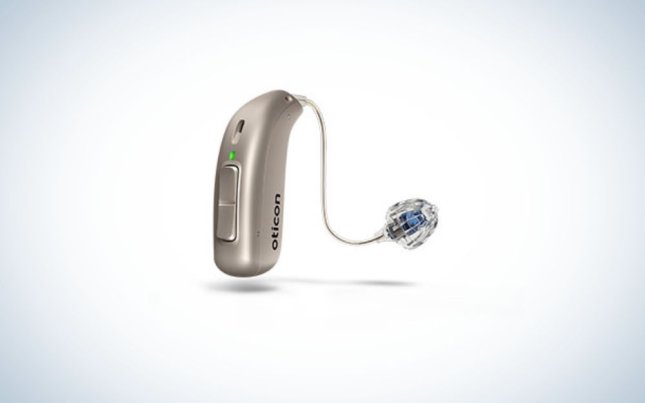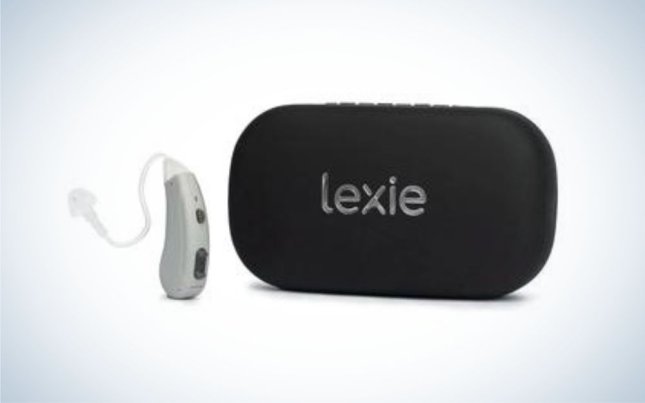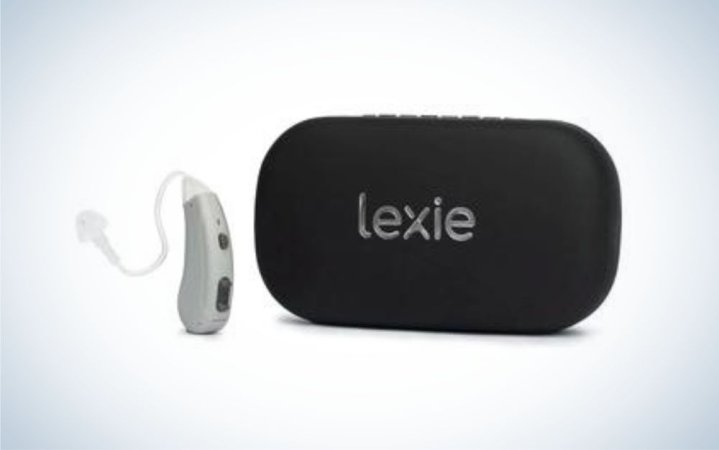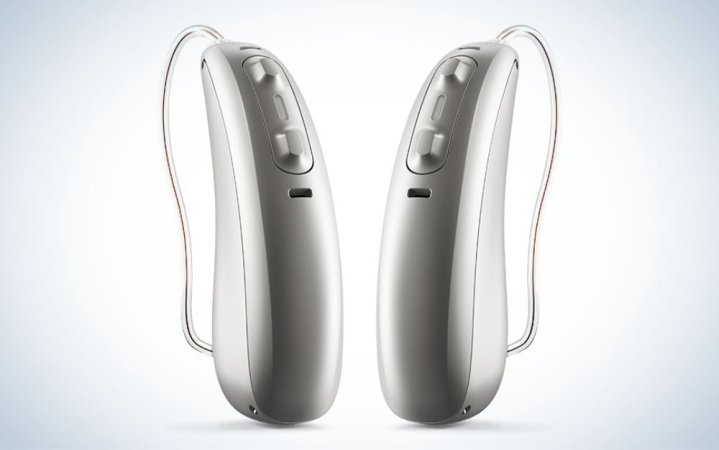We may earn revenue from the products available on this page and participate in affiliate programs. Learn more ›

Hearing aids are medical devices designed to help people with hearing loss hear better by amplifying sound. As medical devices, they are approved and regulated in the United States by the Food and Drug Administration. According to the U.S. National Institute of Deafness and Other Communication Disorders, one in eight people aged 12 and older in the U.S. has some form of hearing loss, and it is especially common in older people. Despite this, less than 30% of people over 70 who might benefit from the best hearing aids have actually tried using them. Even fewer people between 60 and 69 try them.
In the past, hearing aids simply amplified sound. But most modern aids are essentially tiny computers, amplifying sounds you might want to focus on while minimizing background noise. They can also be customized to amplify different frequencies of sound depending on your hearing loss. Audiologists, medical professionals who specialize in treating hearing loss and fitting people with hearing aids, can often help you find and customize your device to work the best for you. Here are some of the best hearing aids recommended by experts and people with hearing loss.
- Best direct-to-consumer package: Lively 2 Pro
- Audiologist’s pick: Oticon More
- Most affordable direct-to-consumer option: Lexie Lumen
- Customer’s pick: Kirkland Signature 10.0
How we chose the best hearing aids
To learn general information about hearing aids and to learn about which product to consider, we spoke with five audiologists and heard from a sixth over email. We considered top-reviewed products endorsed by audiologists, including products made by each of the six major manufacturers in the United States. Preference was given to products and brands suggested or commonly distributed by the experts we spoke with. We considered patient follow-up with audiologists to be especially important, and also considered battery life, cost, Bluetooth compatibility, and general accessibility.
Because of the huge variety and general high quality of many FDA-approved hearing aids, there are few scientific studies that compare more than two or three hearing aids to each other. Because of this, we relied strongly on customer reviews and recommendations from experts. Finally, many high-quality aids exist, and aids not included in this list are not necessarily of bad quality. When consulting with an audiologist, along with researching what you want in a device, you should always consider what they recommend would work best for you.
Things to consider before buying hearing aids
First things first, if you think you might need hearing aids, you should first take a hearing test, preferably at a doctor’s office. The test will measure how well you can hear at a range of different pitches (frequencies). Your doctor will also make sure any hearing problems you have aren’t due to a medical condition or injury that could be treated, such as an ear infection, earwax buildup, or injury to the eardrum. Then your doctor may refer you to an audiologist.
Check your insurance
Usually, insurance will not cover a visit to an audiologist without a referral from a physician, though many types of health insurance will cover the cost of aids once you get a referral. Patients should check with their insurance company to be sure of their policy. Medicare will not cover hearing aids, though Medicaid will in many cases, and in all cases for children.
Pick a style
There are two main styles of hearing aids: in the ear (ITE) and behind the ear (BTE). Within these, there are different subtypes and variations. Some are barely visible—such as “completely in canal” (that is, the ear canal) styles—while “half shell” and “full shell” devices fill larger portions of the ears. BTE styles, as the name would indicate, attach behind the ear, and can be barely noticeable or quite substantial.
The most common type of hearing aid is the receiver-in-ear (RIC) device. These have components that go behind the ear with a very thin wire attached to a tiny speaker that goes in the ear canal. RIC devices don’t block the ear, allowing a person to hear sounds that they can still detect normally. Other styles work well for different severities of hearing loss.
Some smaller in-ear aids might work well for mild or moderate hearing loss, while a larger BTI type might be better with severe or profound hearing loss. RIC aid styles for people with a wide range of hearing loss, from mild to profound. An audiologist can help you choose a style that will work for you.
Direct-to-consumer options
Some companies allow you to skip the step of referral to an audiologist and buy hearing aids directly. These can be more accessible to people and can decrease the cost but many audiologists caution again this approach, especially if there is minimal involvement from audiologists to help you select, customize, and learn to use and maintain your device. “If nothing else, please come get your hearing tested so that you can see what your baseline is and see what your needs are,” said Dr. Rachel Smith, a clinical associate professor of audiology at the University of Rhode Island.
The best hearing aids: Reviews & Recommendations
Best direct-to-consumer package: Lively 2 Pro
Best direct-to-consumer package
Pros
- No need to go through a doctor and/or audiologist
- Virtual audiology care is convenient and potentially more affordable
- Technology is on par with leading hearing aids provided by audiologists
- Relatively affordable when compared to devices you might get through an audiologist
Cons
- Not the most affordable, especially compared to other direct-to-consumer options
- Virtual setup and check-ins may be more difficult for some than in-person care
Why it made the cut: Lively offers a high-quality product, including three years of virtual check-ups with audiologists as part of its package and a three-year warranty, without the hassle of going through an audiologist.
Specs
- Receiver-in-canal style
- 30-hour battery life, rechargeable
- For mild to moderately severe hearing loss
According to experts, working with a clinician is one of the keys to getting a hearing aid that works well for you. With Lively’s packages, you can avoid the hassle of going through a doctor and audiologist without sacrificing the customization and support that audiologists provide to patients. Lively also uses an online hearing test to establish each patient’s level of hearing loss. Plus, Lively’s products are manufactured by ReSound, whose state-of-the-art devices are also available through in-person audiologists.
“With Lively, you’re gonna feel like you have as much care as you would through a regular audiologist’s clinic,” said Dr. Morgan Oktela Fuentes, an audiologist at the University of South Florida Department of Otolaryngology.
The Lively 2 Pro is Lively’s most advanced device, featuring speech clarity and noise reduction technology, providing natural-seeming sound in even noisy environments. It also features Bluetooth compatibility, easily connecting to calls and music, including hands-free calling for the iPhone 11 and newer. The devices are rechargeable, with 30 hours of battery life after each charge in the included charging case, and feature a Music Mode, designed to be used when listening to live music. The hearing aids are controlled using Lively’s free mobile app and come in a variety of colors.
Audiologist’s pick: Oticon More
Audiologist’s pick
Pros
- Powerful, advanced sound processing technology
- Available in various styles and battery types
- Highly customizable by an audiologist
- Bluetooth compatibility with direct calling for some devices
Cons
- Usually only available through an audiologist
- If purchased online, customization may not be as good
- Expensive (though may be covered by insurance)
Specs
- Behind the ear or Receiver in the ear style
- 24-hour battery life, disposable or rechargeable
- For mild to severe hearing loss
Though there are numerous high-quality hearing aid manufacturers and products that audiologists offer at their clinics, multiple audiologists we spoke with mentioned that Oticon products were a popular choice and that patients generally seemed satisfied with them. The Oticon More is the company’s flagship product, with technology designed to mimic the way the brain processes sound, including using a Deep Neural Network, a type of machine learning, built into the device’s software. There are numerous ways that an audiologist can customize each of the three levels of the Oticon More, including different settings for speech clarity and noise suppression.
The easiest way to get the Oticon More is through an audiologist. However, there are ways of going through this process online. MySecondEar, for instance, is an online audiology service where you can get devices usually reserved for the clinic by submitting hearing test results and going through an online consultation process. The service’s audiologist will have the hearing aids shipped directly to you, preset based on your hearing test. You can have the settings readjusted in virtual follow-up appointments. Other websites offer similar services.
Like many hearing aids, Oticon More devices cost thousands of dollars, though they are still more affordable than some. Because they are usually sold by an audiologist with appointments and follow-ups factored in, the price you might pay for them will vary. Merit Hearing, another online audiology service/hearing aid retailer, lists the Oticon More as costing between about $1,400 to $2,200 per device, depending on the features, not including follow-up. However, hearing aids like these can have a notable impact on a person’s life, note experts, making even expensive products a worthwhile investment.
Most affordable direct-to-consumer option: Lexie Lumen
Most affordable direct-to-consumer option
Pros
- Extremely affordable for a hearing aid
- High quality for the price
- No need to go through an in-person audiologist
- Simple app navigation for different device modes
Cons
- Can’t take calls or listen to music
- Not rechargeable
- Slightly bulkier than similar styles
Why it made the cut: If you’re looking for a fairly basic, accessible, affordable hearing aid that is still high-quality, you can’t beat this direct-to-consumer option.
Specs
- Behind the ear/receiver in the ear style
- 36-hour battery life, disposable
- For mild to moderate hearing loss
At $799 for a pair, Lexie’s hearing aids are hundreds or even thousands of dollars cheaper than many clinical options. That makes them an ideal option for anyone who wants to invest in a decent pair of hearing aids but might not have insurance that covers the cost or otherwise be able to afford a more expensive option. Lexie’s direct-to-consumer model also makes it extremely simple to buy these online. As with Lively, Lexie offers an online hearing test and access to experts to help you learn to use the product.
Lexie Lumen hearing aids are “autofit” based on a hearing test you can take online and on their app, which is the same app used to adjust the hearing aid. Specifically designed to be clear even to people who might not be “tech-savvy,” the app allows you to easily switch between different modes, such as those for noisy indoor places, being outdoors, or listening to live music.
Though these hearing aids work and connect to your phone via Bluetooth, you cannot take calls or listen to music through them. This might be a problem for someone who tends to take a lot of cell phone calls. It is also not rechargeable, which is becoming uncommon in modern hearing aids, especially because tiny batteries are often challenging for elderly people to replace. In a review, audiologist Dr. Ben Thompson noted that the devices also seemed about 30% larger than average and the colors are more noticeable, but that the devices were still to wear comfortable, fairly unobtrusive, work as advertised, and seem to be made of quality materials.
“Because of its low initial cost, I believe the Lexie Lumen is an excellent first hearing aid,” Thompson writes.
Customer’s pick: Kirkland Signature 10.0
Customer’s pick
Pros
- Affordable compared to many hearing aids
- Quality technology from a leading manufacturer
- Convenient follow-up care, including remote visits
Cons
- Based on slightly older technology
- Larger than some hearing aids
Why it made the cut: Affordable, accessible, simple to use, and made by a top manufacturer, many people find that this Costco-brand hearing aid provides the best value and experience.
Specs
- Receiver in ear style (custom ear molds sold separately)
- 16+ hour battery life, rechargeable
- Mild to profound
In a 2021 survey of over 26,000 of its members, Consumer Reports found that Kirkland hearing aids had the highest rating for both value and overall satisfaction, while Costco had the highest rating for a retail experience. It’s true that you have to be a Costco member to buy these devices, but for many people, Costco’s Hearing Center may be more accessible than some audiologist clinics. And many people might prefer their remote follow-up appointments for convenience. This hearing aid can also be customized for virtually any level of hearing loss.
Kirkland hearing aids are made by top manufacturer Sonova and are based closely on another hearing aid it makes called the Phonak Audeo Paradise, which is not Phonak’s newest model. That said, they are still good quality, though larger and slightly less customizable than the newest hearing aid technology. It has many popular hearing aid features, such as Bluetooth compatibility for music and calls, including being able to answer calls directly from the hearing aid. It’s also rechargeable.
Like many of the hearing aids on this list, it can be controlled and customized through an app. Because of the most traditional audiologist model, you can also be sure that an expert will help make your hearing aid work as well for you as possible.
FAQs
Hearing aids that are used properly and fit well shouldn’t have notable side effects. Aids that are adjusted to be too loud can cause tinnitus (ringing in the ears) and headaches, while aids that don’t fit properly can hurt the outside of the ear or the ear canal or can be itchy. If they are adjusted right or don’t work well for you, you might not be able to hear well. Sometimes, aids can have acoustic feedback, where they will make a ringing sound, which happens when the hearing aid picks up sound from its speakers that’s already been amplified. Properly adjusted hearing aids should not have excessive feedback, though it may still be an occasional issue.
Hearing aids can be quite expensive, typically ranging from $1,000 up to $6,000 dollars per device. In some cases, insurance may cover the cost of devices. Fuentes says that in many cases, it’s one of the more expensive items a person buys in their life, after their car and home. However, if you can afford it, it can be well worth the investment.
“For a person with hearing loss who has stopped interacting with friends and family due to embarrassment that they cannot hear, a hearing aid has a tremendous value,” wrote Dr. Audrey Taylor, an audiologist with McGovern Medical School at UTHealth Houston, in an email to Popular Science. “Price is what we pay. Value is what we receive.”
Most hearing aids last between three and seven years, though they can last for longer. You can make sure your aids last as long as possible by caring for them properly, which you can learn how to do from your audiologist and/or materials online specific to the hearing aid.
On its own, not wearing a hearing aid is not likely to worsen the physiological causes of hearing loss, such as damage to the tiny hairs on the inside of the ear that allow you to hear. It’s possible to damage your hearing further if you use other means to compensate for your hearing loss, such as listening to extremely loud music or standing very close to speakers. Some inexpensive hearing amplifiers that you can buy at drugstores look like hearing aids but are not approved by the FDA and can sometimes damage your hearing further by overamplifying sounds.
An audiologist can help you learn how to properly clean your hearing aids. An earwax pick and brush are usually used to clear out accumulated earwax. Always wash your hands before cleaning your hearing aid. You can also use water-based disinfectants; Oticon suggests also wearing gloves. Many manufacturers have their own tools for cleaning hearing aids, and there are also many outside products you can buy to help keep your hearing aids clean.
Research shows that the longer someone with hearing loss does not wear a hearing aid, the harder it is for their brain to adjust to sound amplification via aids when they do start using them, says Fuentes. Many people adjust to hearing aids in two or three weeks, but it can take some people as long as four months to get used to them.
Final thoughts on the best hearing aids
Hearing aids can dramatically improve the life of someone with hearing loss, allowing them to communicate with others better and understand more spoken information. With the right, properly fitting device, you can start to appreciate the sounds of the world around you again.







